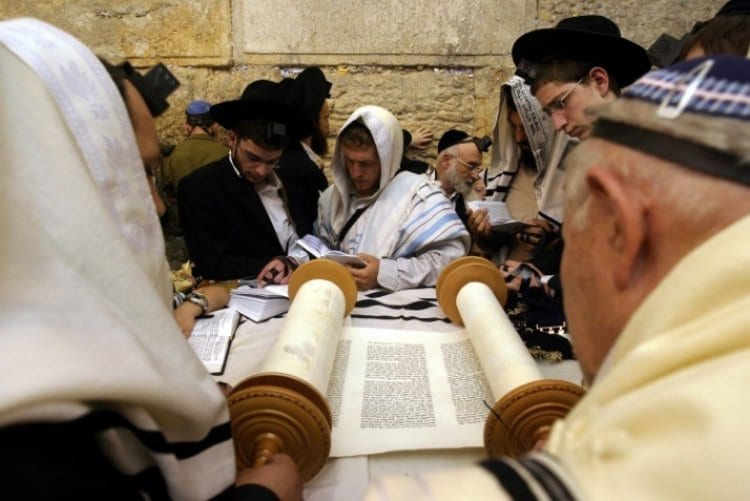
2. The sages call it “The Book of Lamentations”,” The Scroll of Lamentations “or the abbreviated form “Lamentations.”
3. The custom is to read the scroll in public on the night of Tisha B'Av, the day prescribed for fasting over the destruction of both Temples, and some also read it the next morning, during the day of Tisha B'Av.
4. The scroll features dirges dealing with the destruction of Jerusalem and the exile of its inhabitants. The prophet Jeremiah laments the terrible state of Jerusalem during the siege on the eve of the destruction, the bleak and difficult situation of Jerusalem and its inhabitants after the destruction, and the obscured Divine Providence that followed it. He also justified the harsh sentence imposed on its inhabitants because of their many sins and crimes.
5. The scroll is divided into five chapters: the first, second and fourth chapters are similar in character and structure. They all open with the exclamation “How could it be”, and all of them are composed of 22 verses which are organized in an alphabetical acrostic. The verses of Chapter 3 are also organized in alphabetical order, but it has 66 verses with 3 verses starting with each letter. In addition, this chapter does not explicitly mention the destruction of Judea or Jerusalem.
6. Chapter 1 describes the destruction of Jerusalem. Jeremiah paints a vivid picture of a widow weeping at night, with tears on her cheeks, who can find no solace and is abandoned by all of her friends. The implication is that Judea was exiled and her sons were enslaved among the nations, while Zion is sitting, mourning and in ruins, longing for the many pilgrims who used to come through her gates. Jerusalem remembers the bitter destruction, the glorious period preceding it and the fact that no nation had come to her aid. To the contrary, foreign nations with whom the Jews had made a pact and on whom they had relied, reneged on their promises and were happy to see her in ruins.
7. In Chapter 2, the Prophet depicts the tragedy that befell the Jewish people, the decree that had fallen from the heaven to the earth. Jerusalem was burning. The prophet describes children dying from starvation, begging their mothers for food before they expire in their laps. “There is no other similar period in history by which I can comfort you!” the prophet calls out and adds: What is the reason for the Jewish people’s terrible suffering? The false prophets who promised that Jerusalem would never be destroyed and that “no enemies would come to the gates of Jerusalem.”
8. In Chapter 3 Jeremiah describes his private life, which is an allegory for the suffering of a Jew. He describes the hardships and suffering that he experienced during his life, yet does not lose his faith. Later in this chapter the prophet explains that miracles always surround us and that G-d is good to all even during difficult times. Suffering has a purpose — to cry and feel regret for the mistakes and sins we did which caused all the suffering.
9. In Chapter 4, the prophet Jeremiah returns to describe the horrors of the destruction. The golden radiance has faded, the light of the Temple was darkened. The jewels (the Jews) were thrown into the streets! Precious Jewish children were given into the hands of the brutal enemies. Their tongues stuck to their palates from hunger and thirst, and there was no one to give them bread. Pampered children, who were accustomed to delicacies, were now gathering food scraps from rubbish piles. Their bodies were devastated by hunger, until they became unrecognizable. Their faces were blackened and their skin was shriveled on their bones.
“The victims of the sword were better off than the victims of hunger.” (4:9) Death by the sword was far easier than the slow torment of death from hunger pangs. Merciful women reached the point where they cooked their own children! The nations and their kings could not believe their eyes. The blind fell over the bodies in the streets and their clothes soaked up the blood of the dead. Jeremiah prophesies at the end of the chapter about the destruction of the Second Temple.
10. Chapter 5, the last chapter, is dedicated to hoping for the Redemption. The chapter is one long cry of prayer, faith and hope. Remember what happened to us and see our disgrace. Foreigners inherited us; others sit in our homes. We must pay to drink our water and buy the firewood that was ours. Death by starvation … young and old brutally murdered. Our joy has turned into mourning. Our crown was taken from our heads. The end of the chapter has a description of foxes roaming the desolate Mount Zion. “For this our heart has become faint, for these things our eyes have dimmed.” (5:17).
This chapter, which also has 22 verses but in a non-alphabetical order, ends with a plea and cry to G-d: “Restore us to You, L-rd, that we may be restored! Renew our days as of old” which is said in a loud and heartfelt voice by the public. The Cantor then repeats this verse.
The complete Book of Lamentations in a complete and easy to read format, can be found on Hidabrut website’s expanded Torah database.
Nearly two thousand years the Jewish people is mourning the destruction of the Temple by fasting four times a year, keeping mourning rites, and more. Why? What is the meaning of the huge calamity whose echoes continue to reverberate without end until the building of the Third Temple? Rabbi Zamir Cohen explains the profound significance by bringing three layers of meaning to the destruction. The lecture will engage your mind and stimulate longings for Israel’s old days of glory, while explaining the right way to Israel’s true redemption.
